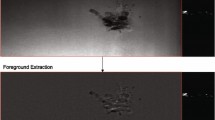Abstract
A machine vision system that has been developed for the detection of missing fasteners on steel stampings is described. The system has been tested using images generated by a commercial machine vision system installed on an assembly line for the production of automotive cross-car beams. This particular application was considered to be challenging due to variations in the operating conditions, such as the lighting, together with the fact that the appearance of the fasteners could change depending upon their angle relative to the camera. A neuro-fuzzy image classification algorithm was developed and tested against a threshold-based classification algorithm. Results indicate that both algorithms perform well when optimized, but the neuro-fuzzy algorithm was found to degrade in a less abrupt fashion when the input data deviated from the trained data. A graphical user interface (GUI) was designed to enable implementation on the assembly line. The developed system is adaptable to other machine vision-based automated inspection applications.
Similar content being viewed by others
References
Davies ER (2005) Machine vision: theory, algorithms, practicalities, 3rd edn. Morgan Kaufmann, New York
Reynolds MR, Campana C, Shetty D (2004) Design of machine vision systems for improving solder paste inspection. ASME int. mechanical engineering congress and exposition, IMECE2004–62133, Anaheim, California, Nov. 13 to 20
Lee KM, Li Q, Daley W (2007) Effects of classification methods on color-based feature detection with food processing applications. IEEE Trans Autom Sci Eng 4(1):40–51. doi:10.1109/TASE.2006.874972
Gayubo F, Gonzalez JL, del la Fuente E, Miguel F, Peran JR (2006) On-line machine vision systems for detect split defects in sheet-metal forming processes. Int. conf. pattern recognition (ICPR’06), Hong Kong, Aug. 20 to 24
Lahajnar F, Kovacic S (2003) A machine vision system for the rotational positioning and verification of oil filters. Int J Adv Manuf Technol 21:452–459. doi:10.1007/s001700300053
Garcia HC, Villalobos JR, Runger GC (2006) An automated feature selection method for visual inspection systems. IEEE Trans Autom Sci Eng 3(4):394–406. doi:10.1109/TASE.2006.877399
Hunter JJ, Graham J, Taylor CJ (1995) User programmable visual inspection. Image Vis Comput 13(8):623–628. doi:10.1016/0262-8856(95)97287-V
Kwak C, Ventura A, Tofang-Szai K (2000) A neural network approach for defect identificaton and classification on leather fabric. J Intell Manuf 11:485–499. doi:10.1023/A:1008974314490
Killing J, Surgenor BW, Mechefske CK (2007) Robust machine vision-based parts inspection: intelligent neuro-fuzzy versus threshold-based classification. ASME Int. manufacturing science and engineering conf., MSEC2007–31196, Atlanta, Georgia, Oct. 15 to 17
Yang T, Tsai TN (2004) A neuro-fuzzy-based quality-control system for fine pitch stencil printing process in surface mount assembly. J Intell Manuf 15:711–721. doi:10.1023/B:JIMS.0000037719.35871.aa
Gonzalez RC, Woods RE, Eddins SL (2004) Digital image processing using MATLAB. Prentice Hall, Saddle River
Killing J (2007) Design and development of an intelligent neuro-fuzzy system for automated visual inspection. M.Sc. Thesis, Queen’s University, July 2007
Jang JSR, Sun CT, Mizutani E (1997) Neuro-fuzzy and soft computing: a computational approach to learning and machine intelligence. Prentice-Hall, Saddle River
Jang JSR (1993) ANFIS: adaptive-network-based fuzzy inference system. IEEE Trans Syst Man Cybern 23(3):665–685. doi:10.1109/21.256541
Chiu SL (1994) Fuzzy model identification based on cluster estimation. J Int Fuzzy Syst 2:267–278
Sezgin M, Sankur B (2004) Survey over image thresholding techniques and quantitative performance evaluation. J Electron Imag 13(1):146–165. doi:10.1117/1.1631315
Kang DK, Chung YK, Doh WR, Jung W, Park S-B (1999) Applying object modelling technique to automated visual inspection of automotive compressor parts omission. Int J Machine Tools Manuf 39:1779–1792
Finlayson GD, Hordley SD, Hubel PM (2002) Illuminant estimation for object recognition. COLOR Res Appl 27(4):260–270. doi:10.1002/col.10064
Author information
Authors and Affiliations
Corresponding author
Rights and permissions
About this article
Cite this article
Killing, J., Surgenor, B.W. & Mechefske, C.K. A machine vision system for the detection of missing fasteners on steel stampings. Int J Adv Manuf Technol 41, 808–819 (2009). https://doi.org/10.1007/s00170-008-1516-3
Received:
Accepted:
Published:
Issue Date:
DOI: https://doi.org/10.1007/s00170-008-1516-3




